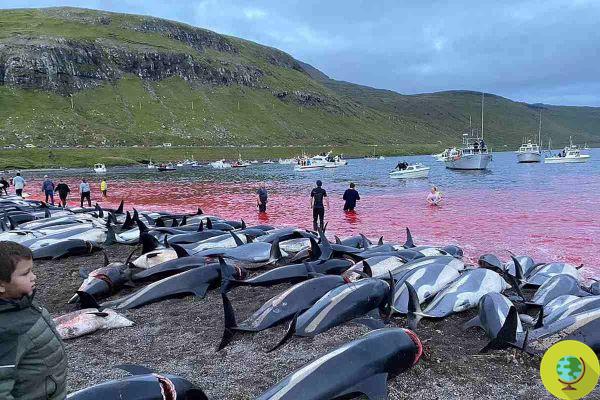
The worst cetacean massacre of the last 80 years took place in the Faroe Islands this year, but this bloody tradition has been going on for centuries
Red sea, soaked in blood, and over a thousand beached cetaceans, killed with harpoons and knives: the shocking images from the Faroe Islands have traveled around the world, sparking a wave of indignation. What has just ended was the worst slaughter of pilot whales and dolphins in recent decades.
They are in total 1.428 marine mammals brutally killed, even with a drill. And although this year the event had a strong media coverage, actually in Denmark there Lattice killing (which in the Faroese language literally means "whaling") has been repeated regularly every year for centuries. And, even today, in 2021 it is a much loved ritual, which many want to protect and carry on in the name of tradition. For the local inhabitants it is a day of celebration and even the little ones are called to attend the macabre spectacle of cetacean hunting.
#ICYMI – Over the weekend, whalers in the Faroe Islands set a gruesome record, killing a full 1428 dolphin-superpod. It'…
Posted by Sea Shepherd on Wednesday, September 15, 2021
Unfortunately, the mobilizations and petitions launched over the years by environmental associations such as Sea Shepherd have so far been of no use.
Read also: The slaughter of pilot whales in the Faroe Islands has started again. A drone that filmed the massacre was also hit with a weapon
Index
Grindradráp: an ancient rite introduced by the Vikings
As anticipated, in Denmark "whaling" has very ancient origins. Already in the tenth century it was practiced by the Vikings and in the following centuries the practice became very important for the local populations as whale meat and fat constituted a large part of the diet for the inhabitants of the Faroe Islands. The whale was not only used as food, but its fat was considered precious to transform it into oil to be used for lighting, while it was used to make ropes for boats. In the past, hunting of marine animals was also very common in Iceland and on the Hebridean islands.
Grindadráp, also known as Grind, has been passed down from generation to generation and most of the residents of the Faroe Islands are very fond of this tradition, which is an integral part of their culture and which has now been regulated. A survey carried out by public TV Kringvarp Foroya revealed that while 50% of people are against dolphin hunting, 80% are in favor of whale hunting.
How the slaughter takes place
The cruel practice, authorized by law, consists of dragging marine mammals ashore, surrounded by fishing boats in a bay and then slaughtering them with knives and harpoons. Subsequently, the meat is distributed to the population for consumption. Hunters mainly target dolphins and pilot whales, also known as pilot whales. These are not commercial hunts, but organized at community level, often spontaneously when someone spots a herd of mammals. And to participate, hunters must have an official training certificate that qualifies them to kill animals.
An average of 600 pilot whales and 40 dolphins are killed annually. But in some cases, as happened this year, staggering figures are reached and, consequently, the event acquires greater media coverage. In recent days, even the president of the Faroese Whalers Association, Olavur Sjurdarberg, acknowledged that the killings were excessive to the BBC's microphones. But the real problem is not represented by the number of specimens killed, but rather by the terrifying ritual considered by the government authorities.
The attempts (so far in vain) to stop the bloody tradition
It is damage that animal rights and environmental organizations around the world, starting with Sea Shepherd (which every year documents the horror with photos and videos), are fighting to abolish this terrifying practice. But so far the various appeals have never been accepted by the Danish authorities.
On Sunday night a super-pod of 1428 Atlantic White-Sided Dolphins was driven for many hours and for around 45 km by speed boats and jet-skis into the shallow water at Skálabotnur beach in the Danish Faroe Islands, where every single one of them was killed. https://t.co/uo2fAPhCDq
— Sea Shepherd (@seashepherd) September 14, 2021
The last petition (CLICK HERE to sign) in chronological order was launched by a volunteer of the association Blue Planet Society, which is addressed not only to Steig Nielsen, prime minister of the Faroe Islands but also to the Japanese prime minister, given that even in Japan every year hundreds of cetaceans are hunted in the coastal city of Taiji, in what has been renamed Bay of Death.
But what can we do in our own small way to stop these inhumane practices? First of all, to sign the various petitions, but also to deepen the theme and raise awareness on the matter, in the hope that the great visibility given to the issue can lead to the abolition by law of this abomination that we have to witness every year.
Follow us on Telegram | Instagram | Facebook | TikTok | Youtube
Fonti: Sea Shepherd / Change.Org
Read also:
- 1.500 dolphins were slaughtered in the Faroe Islands, the largest in the last 80 years
- The slaughter of pilot whales in the Faroe Islands has started again. A drone that filmed the massacre was also hit with a weapon
- Taiji Bay: the hunt (and slaughter) of dolphins starts again. Already captured 4 specimens
- Hundreds of dolphins and pilot whales slaughtered in the Faroe Islands


























